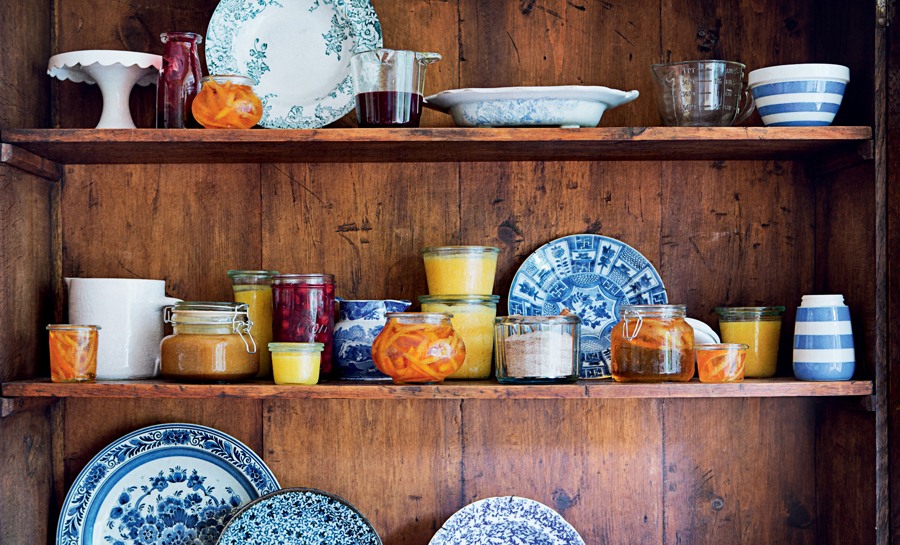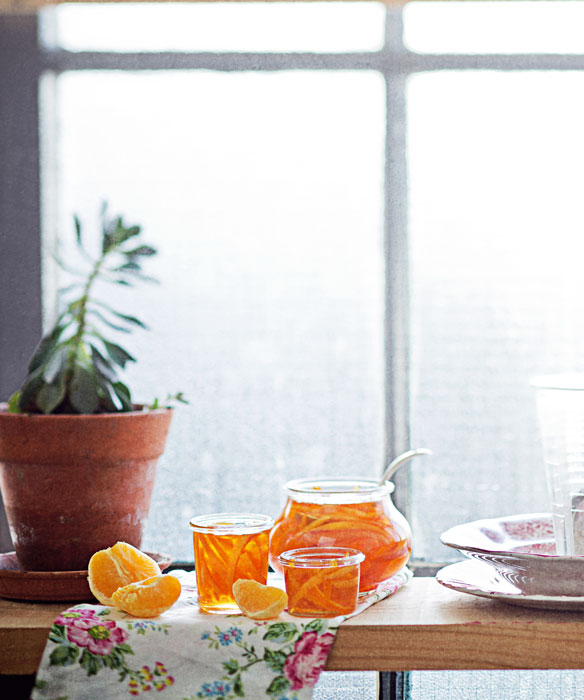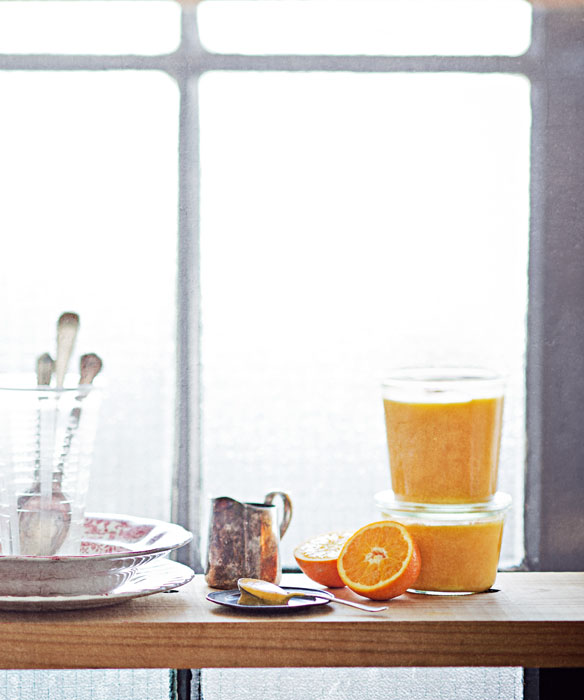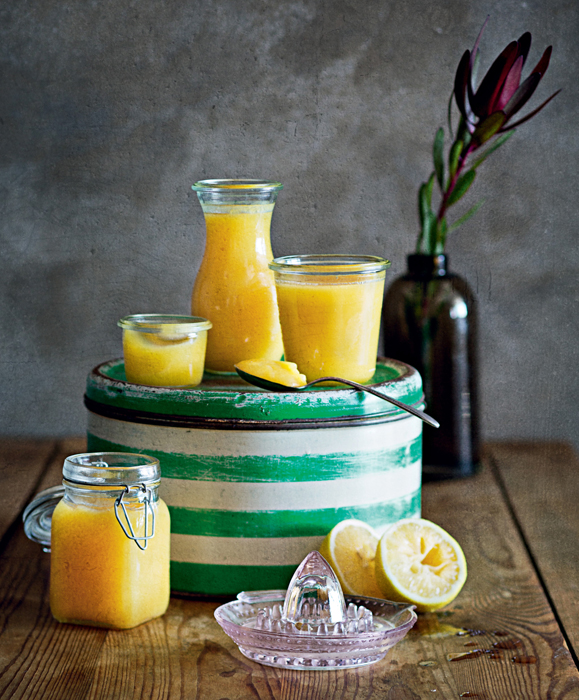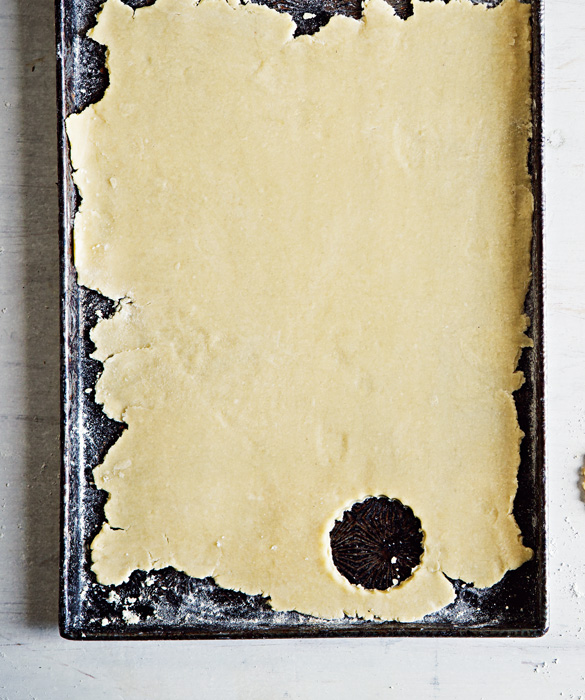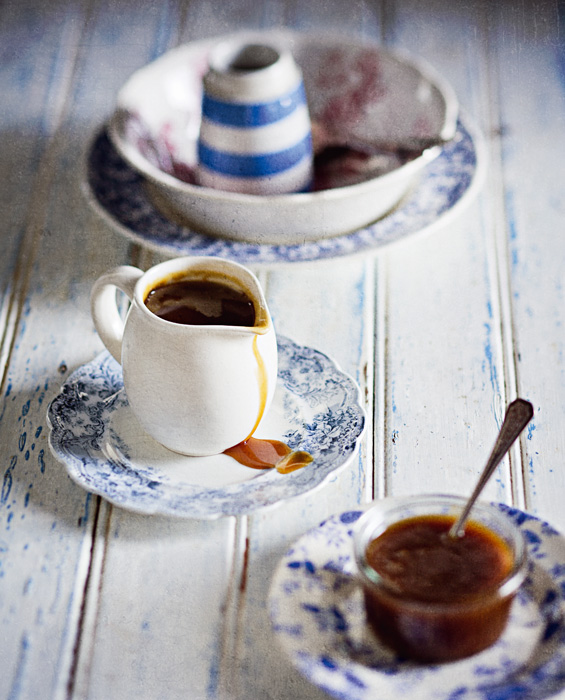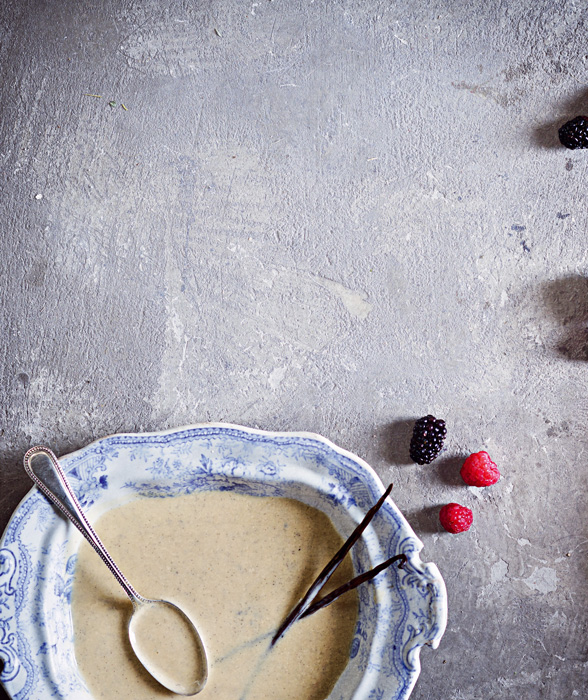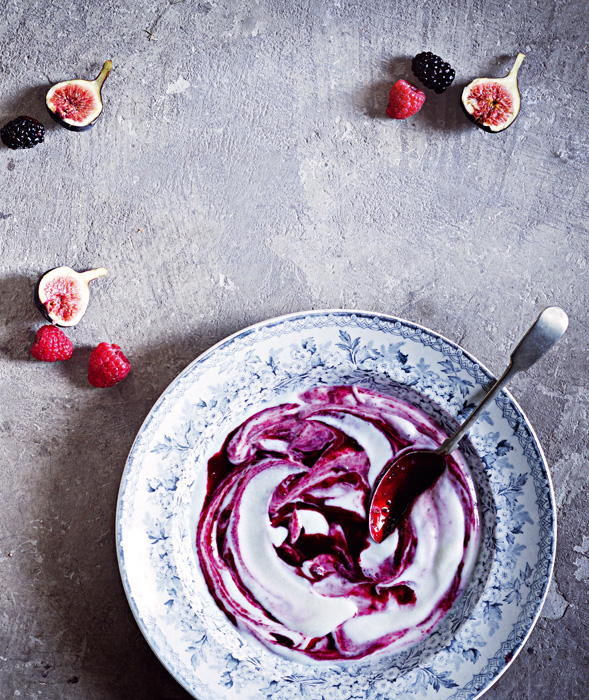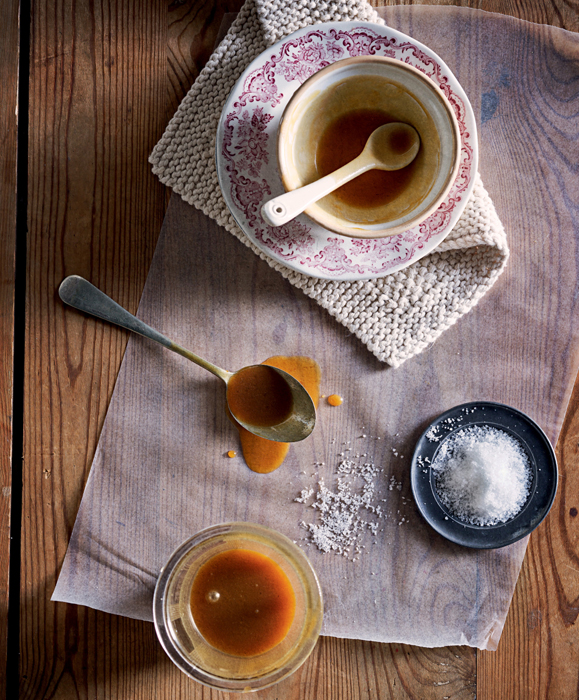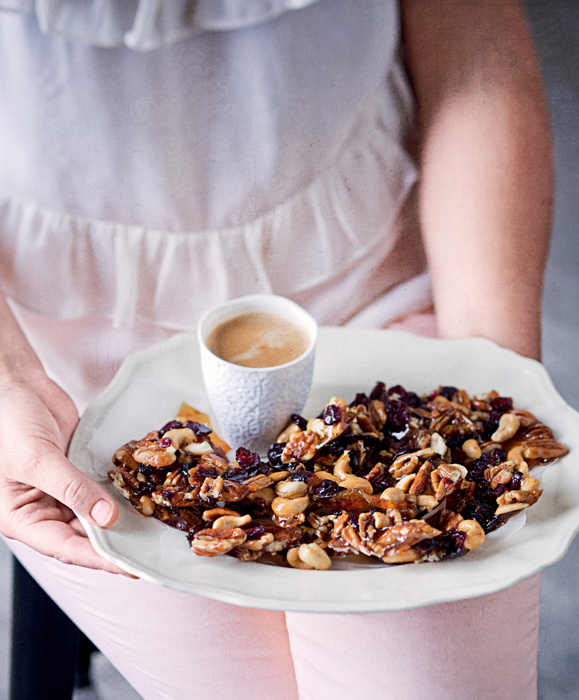HOME-MADE ESSENTIALS
These are the things I always have in my fridge, freezer or pantry cupboard as they’re vital to so many baked recipes
MUM’S MARMALADE
(Pantry cupboard)
So simple to make; these recipes don’t require sugar thermometers and hours of time.
- for every 6 oranges, use
- 2 lemons
- white sugar
PREPARATION
- Squeeze the oranges and lemons. Scrape the pith and remaining fruit from the peels. Place the pith, fruit and juice in a saucepan over medium heat (retain the peels). Boil for 20 minutes, then strain through a muslin cloth and retain the liquid.
- Cut the orange and lemon peels into thin strips. Place 1 part fruit peel into 3 parts water (mix the water and the retained boiling liquid to make up the 3 parts of the water mixture). Soak overnight.
BOILING AND SETTING
- Boil the peels and water for approximately 11⁄2 hours, until the peels are tender.
- Measure 1 part fruit to 3⁄4 parts sugar and boil small quantities at a time for 25 minutes. I usually boil 8 parts fruit to 6 parts sugar at a time.
- While boiling, place a plate in the fridge and test a little of the marmalade on the cold plate to see if it has set − it will form slight ripples once set. Let the jam cool on the plate in the fridge to be certain. If not set, continue to boil for a further 5–10 minutes. Scoop the scum off the top of the marmalade.
BOTTLING
- Sterilize jars and lids (see preparation on opposite page), and divide the marmalade between the jars. Cover with wax paper and seal.
AUTHOR’S TIP: You can adapt the recipe to make Seville marmalade or three-fruit marmalade. For Seville marmalade substitute the oranges with Seville oranges. For three-fruit marmalade use 6 Seville oranges, 2 grapefruit and 2 lemons (note: when making three-fruit marmalade, the marmalade won’t be as clear as traditional marmalade).
ORANGE CURD
(Fridge)
I love lemon curd so much that it took me ages to make orange curd. The balance is very different to that of lemon curd, and can add a delicious and unique flavour to desserts. They have both become a must-have in my fridge. All varieties of curd will keep for up to three months when stored in the fridge.
- juice and zest of 3 medium oranges
- juice and zest of 1 lime
- 100 g butter
- 250 g castor sugar
- 3 extra large eggs, whisked
PREPARATION
- Sterilize a 250 ml jam jar by boiling the lid and jar in water for 5 minutes.
TO MAKE THE CURD
- Cook the orange and lime juice and zest, butter and sugar in a small heavy-based saucepan over low heat, until the sugar has dissolved. Temper a bit of the sugar mixture into the whisked eggs (see page 5), then add that to the remaining sugar mixture and lower the heat. Continue whisking until the curd has thickened. Do not boil.
STRAINING AND BOTTLING
- Strain the curd into the jar and refrigerate when cool. The curd should stand overnight before use.
Makes 250 ml
LEMON CURD
(Fridge)
Lemon curd is the most underrated product – I use it all the time. This home-made version is delicious and easy to make, so don’t be put off!
- juice and zest of 4 medium lemons
- 100 g butter
- 250 g castor sugar
- 3 extra large eggs, whisked
PREPARATION
- Sterilize a 250 ml jam jar by boiling the lid and jar in water for 5 minutes.
TO MAKE THE CURD
- Heat the lemon juice and zest, butter and sugar in a small heavy-based saucepan over low heat, stirring until the sugar has dissolved. Temper a bit of the sugar mixture into the whisked eggs (see page 5), then add that to the remaining sugar mixture and lower the heat. Continue whisking until the curd has thickened. Do not boil.
STRAINING AND BOTTLING
- Strain the curd through a fine sieve into the prepared jar and refrigerate when cool. The curd should stand overnight before use.
Makes 250 ml
PASSION FRUIT CURD
(Fridge)
This curd is different to others as it retains the acidity, yet has a sweet fruity aftertaste. My number 1 home essential.
- juice and zest of 3 medium lemons
- 100 g butter
- 250 g castor sugar
- 4 extra large eggs, whisked
- pulp of 4 passion fruits
PREPARATION
- Sterilize a 250 ml jam jar by boiling the lid and jar in water for 5 minutes.
TO MAKE THE CURD
- Heat the lemon juice and zest, butter and sugar in a small heavy-based saucepan over low heat, stirring until the sugar has dissolved. Temper a bit of the sugar mixture into the whisked eggs (see page 5), then add that and the passion fruit pulp to the remaining sugar mixture and lower the heat. Continue whisking until the curd has thickened. Do not boil.
STRAINING AND BOTTLING
- Strain the curd into the jar and refrigerate when cool. The curd should stand overnight before use.
Makes 250 ml
SHORTCRUST PASTRY
(Freezer/fridge)
This pastry is mainly used when making savoury tarts but I like to use it when making very sweet tarts too as the saltiness of the pastry balances the sweet filling.
- 250 g cake flour
- a pinch of salt
- 125 g butter, softened but cool
- 45 ml cold water
TO MAKE THE PASTRY
- Sift together the dry ingredients and rub in the butter until the mixture resembles fine breadcrumbs. Add the cold water and knead lightly until it comes together in a smooth dough. Wrap in clingfilm and rest for 30 minutes in the fridge, then roll it out to 1.5 cm-thickness. If you are only using the pastry at a later stage, freeze it in a ball covered in clingfilm and roll it out once defrosted.
AUTHOR’S TIP: If you wrap this pastry well, date and freeze it, it will keep for up to one year.
Makes 250 g
SWEET SHORTCRUST PASTRY
(Freezer/fridge)
To be used when making a tart which has an acidic, bitter chocolate or fruity filling.
- 250 g cake flour
- a pinch of salt
- 30 ml icing sugar
- 125 g butter, softened but cool
- 1 egg yolk, whisked
- 20 ml cold water
TO MAKE THE PASTRY
- Sift together the dry ingredients then rub in the butter until the mixture resembles fine breadcrumbs. Add the egg yolk and cold water and knead lightly until it comes together in a soft dough. Wrap in clingfilm and rest for 30 minutes in the fridge, then roll it out to 1.5 cm-thickness. If you are only using the pastry at a later stage, freeze it in a ball covered in clingfilm and roll it out once defrosted.
Makes 250 g
PUFF PASTRY
(Freezer/fridge)
- 250 g cake flour
- a generous pinch of salt
- juice of 1 lemon
- 180 ml cold water
- 250 g butter
- flour for rolling
TO MAKE THE PASTRY
- Sift the dry ingredients into a large bowl. Make a well in the centre and add the lemon juice and cold water. Knead together to form a soft, pliable dough. On a lightly floured surface, roll out the dough into a 2 cm-thick square. Place the butter between two sheets of greaseproof paper and flatten it a little with a rolling pin. Place the flattened butter in the centre of the dough and fold the sides of the dough over it, sealing it in completely.
- Cover with clingfilm and refrigerate for 30 minutes. On a lightly floured surface, roll out the dough into a 2 cm-thick rectangle. First fold over the top third of the dough, then fold the bottom third over that, turn the pastry 90 degrees and repeat this process. Cover and refrigerate for 30 minutes or until the pastry is cold enough to work with easily.
- Repeat the rolling, folding and turning process four more times in two intervals, chilling the pastry each time. Once all six turns have been done, the pastry is ready. Refrigerate for at least 1 hour before use.
AUTHOR’S TIP: Use this pastry when making tarte tatin, custard slices or mille-feuille. The crisp puffed flakiness of the pastry adds a perfect contrasting texture to the smoother fillings.
Makes 250 g
BUTTERSCOTCH SAUCE
(Fridge)
A silky smooth sauce with a sweet caramelized taste.
- 100 ml golden syrup
- 35 ml butter
- 80 g treacle sugar
- 100 ml cream
- 5 ml vanilla essence
- pinch of salt
PREPARATION
- Sterilize a 250 ml jam jar by boiling the lid and jar in water for 5 minutes.
TO MAKE THE SAUCE
- Place the syrup, butter and sugar in a small saucepan and bring to the boil, then remove from the heat and stir in the cream. Return to the heat and simmer for 2–3 minutes. Add the vanilla essence and salt. Pour into the prepared jar and set aside to cool and thicken.
AUTHOR’S TIP: This sauce will keep for up to one month in the fridge. Remember to label and date it on the jar lid.
Makes 250 ml
SWEET SPICED SUGAR
(Pantry)
You can use this for almost any sweet dish, whether it is folding it into whipped cream, flavouring Crème Anglaise, ice cream or pavlova or simply sprinkling it over pancakes. This is a true essential.
- 250 g castor sugar
- 2 cinnamon sticks
- 30 ml ground cinnamon
- 15 ml ground nutmeg
- 1 vanilla pod, split and deseeded
TO MAKE THE SUGAR
- Simply mix together all the ingredients, place in an airtight container and give it a good shake. It lasts until it’s finished.
Makes just over 250 g
CRÈME ANGLAISE
(Fridge)
Crème Anglaise, the home-made version of custard, has a completely different taste to the store-bought product. It is well worth making yourself.
- 5 extra large egg yolks
- 80 g castor sugar
- 500 ml full cream milk
- 1 vanilla pod, split
TO MAKE THE CUSTARD
- Whisk the egg yolks and sugar together until pale, thick and fluffy. Scald (heat until just before it reaches boiling point) the milk with the vanilla pod. Strain the milk and discard the pod. Slowly stir the milk into the egg mixture. Pour the mixture into a heavy-based saucepan and return the custard to a very low heat, stirring continuously until it has thickened. Do not let the custard boil.
- Strain through a sieve and set aside to cool to room temperature. Cover the top of the custard with a sheet of clingfilm to prevent a skin from forming and refrigerate.
AUTHOR’S TIP: Store the Crème Anglaise in a clean, sealable container. Will keep for up to one week in the fridge.
Makes about 600 ml
MIXED BERRY COULIS
(Fridge/freezer)
A fruity dressing with a sharp edge, often served with cakes, pudding and pastries to cut through the sweet flavour.
- 250 g mixed frozen berries
- juice of 1 lemon
- 85 g castor sugar
TO MAKE THE COULIS
- Heat the frozen berries, lemon juice and castor sugar in a heavy-based saucepan over medium heat and simmer until the sugar has dissolved. Pour the berry mixture into a food processor, blend until smooth and strain through a sieve. Set aside to cool.
AUTHOR’S TIP: Stored in an airtight container, it can keep for up to two weeks in the fridge. If the mixture becomes fizzy, it has passed its shelf life and should be discarded. I like to freeze it in small quantities and defrost as I need it.
Makes 250 g
POACHED QUINCES
(Fridge)
Quinces are only in season for a short period, and they are delicious if poached properly.
- 250 ml granulated
- sugar
- 125 ml water
- juice of 1⁄2 a lemon
- pinch of salt
- 2 quinces, peeled and cored
- fresh mint leaves
TO MAKE THE POACHING SYRUP
- Heat the sugar, water, lemon juice and salt in a small saucepan over low heat. Stir continuously until the sugar has dissolved. Bring to the boil then reduce the heat and simmer for 5 minutes.
POACHING
- Cut a circle, slightly bigger than the saucepan you are using, from baking paper. Cut each quince into 8. Add to the syrup, fold the edge of the baking paper circle and place into the saucepan, covering the top of the syrup. Poach for 15–20 minutes or until the quinces are soft and cooked through.
BOTTLING
- When completely cooled, add the mint leaves, decant into a sterilized jar and refrigerate. The quinces will keep for up to one year.
AUTHOR’S TIP: This is a standard poaching liquid and can be used to poach any fruit, although the poaching time may differ. Monitor the liquid and don’t let it boil rapidly.
Makes 250 ml
SALTED CARAMEL
(Fridge)
A pinch of salt in anything sweet does wonders to enhance the flavour. Caramel is the exception, you can add more than just a pinch. My number 2 home essential.
- 100 ml golden syrup
- 75 g butter
- 75 g Demerara sugar
- 75 g castor sugar
- 125 ml double thick cream
- 15 ml Maldon salt
TO MAKE THE SAUCE
- Heat the syrup, butter and sugars in a small saucepan and bring to the boil. Remove from the heat and stir in the cream and salt. Return to the heat and simmer for 2–3 minutes. Pour into sterilized jars and set aside to cool and thicken.
AUTHOR’S TIP: The caramel will keep for up to three months. It can also be frozen in the jar or a sealable plastic container.
Makes 350 ml
SUGAR SYRUP
(Fridge)
The sweet version of stock, sugar syrup is used for sorbets, sweet terrines, glazing, poaching fruit, crystallizing fruit and Italian meringues.
- 500 g granulated sugar
- 500 ml water
- juice of 1⁄2 a lemon
TO MAKE THE SUGAR SYRUP
- Heat the sugar, water and lemon juice in a large saucepan over medium heat, stirring continuously until the sugar has dissolved. Brush any sugar particles off the side of the pan with a wet pastry brush to prevent sugar crystals from forming. Once all the sugar has dissolved, increase the heat and boil for 5 minutes.
AUTHOR’S TIP: Allow the mixture to boil until all the sugar has dissolved. Undissolved sugar can cause the syrup to crystallize.
Makes 500 ml
PRALINE
(Pantry cupboard)
This is a standard recipe for a praline. I like to make it with almonds, but you can use your choice of nuts, or a mixture.
- 300 g granulated sugar
- 1 litre water
- 15 ml lemon juice
- 200 g nuts of your choice, toasted
- 100 g dried cranberries
PREPARATION
- Line a baking tray with baking paper and generously grease with oil.
TO MAKE THE PRALINE
- Heat the sugar, water and lemon juice in a medium saucepan over low heat. Stir continuously until the sugar has dissolved. Scatter the nuts and cranberries onto the prepared baking tray. Bring the sugar water to the boil and boil until the sugar starts to caramelise. Quickly remove the pan from the heat and swirl the caramel around. Pour the caramelised sugar over the nuts, leave to cool completely and harden. Break into shards, or place in a blender and blitz.
AUTHOR’S TIP: It is important to watch your sugar continuously as it caramelises very quickly. Work fast when it starts to turn into caramel as it also burns quickly.
Fills one medium baking tray
